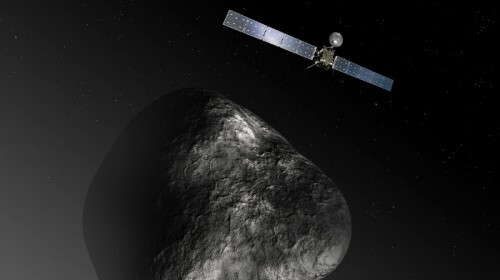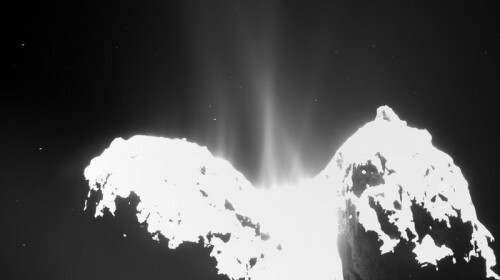Rosetta sheds new light on the history of water in Israel

A month ago, the world of science celebrated the first landing in history on a comet. However, the scientific discoveries of the successful mission are only now beginning to be published. The Rosetta spacecraft, which launched the lander to the comet Churyumov Garsimenko, came close to the comet already in May last year, and in August entered orbit around it. Even then, Rosetta began to collect a lot of data on the comet with its instruments, and to sample the gases and dust emitted from it as it approaches the Sun and heats up. One of the first findings from these samples directly concerns the source of water on Earth.
Heavy and light
Comets are mostly made of ice, so the conventional explanation was that comets that collided with the early Earth were the main source of ocean water. This explanation can be checked relatively easily, when you have good access to the comet. The reason is that comets have not changed much since the beginning of the solar system, and their chemical composition remains the same. Therefore, if comets were the main source of water on Earth, the composition of their water should be similar to our sea water. What is meant by a similar composition? As you know, water is made up of oxygen and hydrogen. The hydrogen atoms exist in several forms, differing in their atomic weight, but not in any chemical property. The nucleus of a "normal" hydrogen atom contains only a proton. A rarer form of hydrogen, also contains one neutron in the nucleus, therefore its weight is double, and such an atom is called deuterium. On Earth, about one in every 6,400 hydrogen atoms is a deuterium atom. An even rarer form is tritium - a hydrogen atom whose nucleus contains a proton and two neutrons - which hardly exists naturally. Since one water molecule consists of one oxygen atom and two hydrogen atoms, only one out of every 41 million (6,400*6,400) water molecules will contain two deuterium atoms. Such a molecule is approximately 10% heavier than normal water, therefore it is called "heavy water". Now we can return to the comet: if the frequency of heavy water in cometary ice is similar to its frequency on Earth, it can be assumed that most of the water came from comets. On the other hand, if the ratio is not appropriate, we need to look for another source for our water.
The rocks of our existence
One of the instruments in the Rosetta spacecraft is a spectrometer called "Rosina", capable of remotely measuring the mass of various materials, including the water vapor emitted by the comet. The findings, published today in the journal Science, revealed that the concentration of heavy water in the ice of the comet "Churyumov Garsimenko" is about three times higher than its concentration in the water of our oceans, and also considerably higher than that found on other comets. "The relatively large amount of heavy water compared to light water means that the comets are probably not the ones that brought most of the water to Earth after it was formed," explains Prof. Akiva Bar-Nun from Tel Aviv University, one of the initiators of the Rosetta program, who is a partner in the research conducted through it . "Our water was probably contributed by the rock blocks that also contributed to the Earth its mass, i.e. asteroids that hit the ancient Earth." Such asteroids contained both ice and water molecules trapped within their rocks. The analysis of the water composition of meteorites, which are fragments of asteroids that reach the Earth, supports this theory, explains Bar-Nun.
The beginning of the road

The mystery of the source of the water on Kdhua is still far from a complete solution. Rosetta's findings point to a high variability in the water composition of different types of comets, probably due to the fact that they were formed in different regions of the solar system. This of course complicates the picture more, because it is possible that different types of comets and asteroids contributed in different proportions to the final water composition formed here. Nor should we rule out the possibility that processes that took place on Earth, such as exposure to radiation following an asteroid impact, did not gradually change the composition of the water. However, examining the composition of water is only a tiny part of the vast amount of scientific data collected from Rosetta, as well as from its lander, Philae. More and more articles are expected to be published in the coming months, and more data will be collected as the comet gets closer to the sun and emits more gases and dust. Of course, all of these join other missions that are supposed to explore asteroids, such as the Japanese "Hyabusa" that was launched last week. The data are expected to greatly contribute to our knowledge of the solar system, which even today, after almost six decades of space flights, we are just beginning to get to know.

5 תגובות
There are six types of water molecules:
1: Normal water: each hydrogen atom has only 1 proton
2: Water? : One hydrogen atom also contains 1 neutron (deuterium)
3: Heavy water: both hydrogen atoms contain 1 neutron each (tritium)
4. Water ??: one hydrogen atom contains only a proton and the other (tritium)
5. Water ???: oxygen atom + deuterium + tritium
6. Water ????: oxygen atom + tritium + tritium
a question
The mass of (a molecule of normal water + a molecule of heavy water) is equal to the mass of (2 molecules containing deuterium). So how could the concentration of heavy water be determined?
When the ice on the comet melts, it spreads out into space (this is the tail of the comet). He doesn't get a second chance to freeze.
I agree with the skeptic, and in addition, another interesting question - after all, the comet flies in space in a complete vacuum, and the water measured is from the ice in its mantle. Who said this sky is not bombarded for billions of years with cosmic radiation that carries out nuclear processes in this ice? How can you even compare ice that flies in space without a magnetic field and without protection at all from cosmic radiation that is several orders of magnitude stronger than what our accelerators are able to produce, for billions of years, in different places in our solar system (both much closer to the sun, and at the edge of the solar system), to water that were trapped in the Earth 4 billion years ago and apparently have been protected for billions of years under the Earth's atmosphere and magnetic field.
Just an example - our solar system may have passed through a nebula with a high concentration of deuterium (heavy hydrogen) a billion years ago. At the same time, the aforementioned comet went through several rounds within our solar system, the ice in it melted and resolidified, evaporated into steam and vapor and returned and crystallized, and during this time it was bombarded with deuterium ions from the aforementioned nebulae.
Obviously, the water on Earth, under the cover of a full atmosphere and a magnetic field, will obviously not absorb the aforementioned deuterium into them.
In my opinion, an in-depth analysis should be performed right in the depths of the comet - perhaps even in its nucleus - which I do not know if it is possible in terms of the instruments on the aforementioned probe. Also, you need to check several comets - not just one.
Agree with a skeptic.
Are there many more question marks to the speculation presented?
What is the number of comets that had to collide with the earth to cover it with water? Is this a realistic amount?
Why is the earth covered with water and not other planets? Comets may also collide with other planets.
Where did the water come to the comets themselves?
Speculation in the shekel. One comet is not a representative sample.
And in general, who guarantees that some of the heavy water does not undergo nuclear processes already when it is on the earth or in the solidification stages of the earth (a nuclear process that is not necessarily a normal hydrogen fusion).